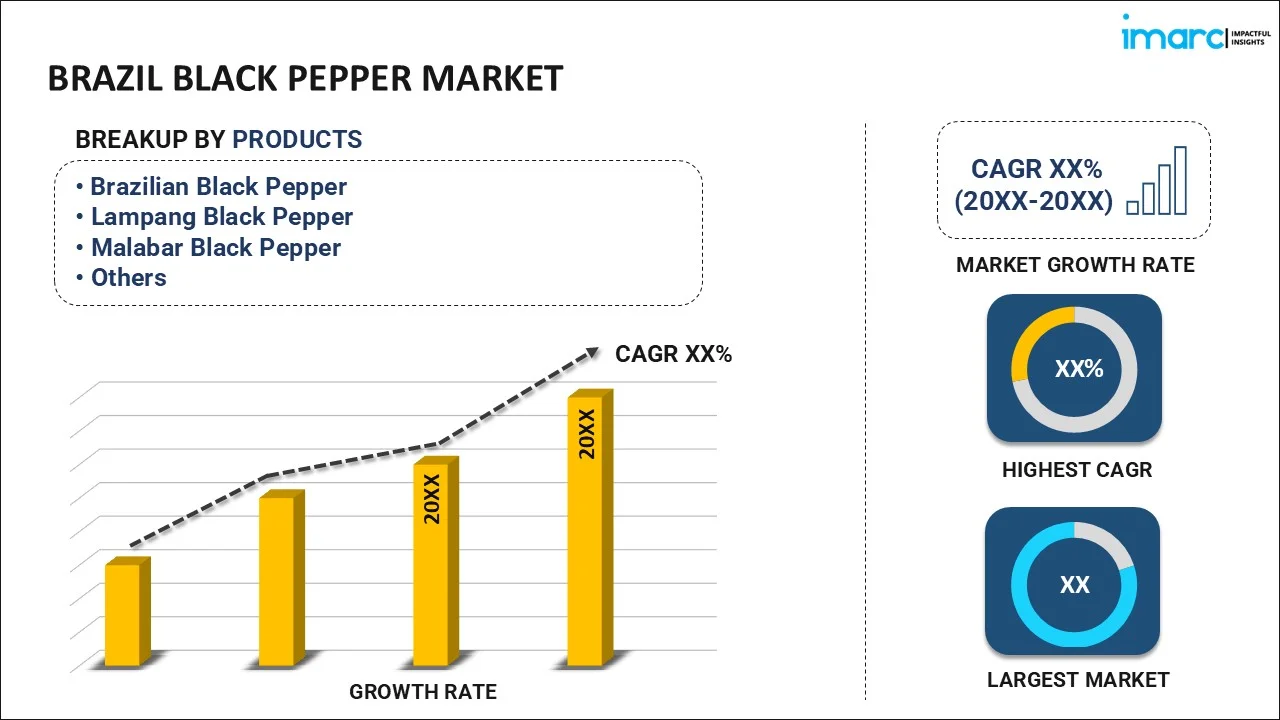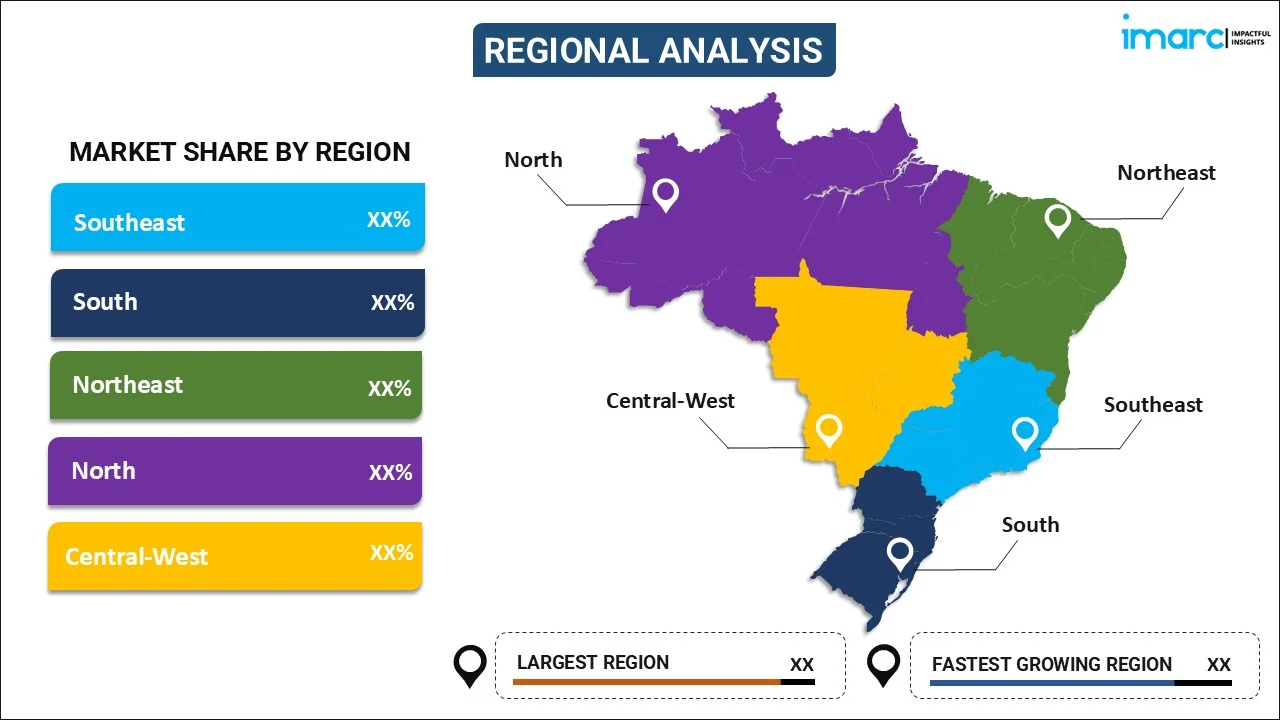
Brazil Black Pepper Market Size, Share, Trends and Forecast by Product, Source, Form, Distribution Channel, Application, and Region, 2025-2033
Brazil Black Pepper Market Overview:
The Brazil black pepper market size reached USD 0.10 Billion in 2024. Looking forward, IMARC Group expects the market to reach USD 0.14 Billion by 2033, exhibiting a growth rate (CAGR) of 4.20% during 2025-2033. The market is propelled by the increasing consumer preference for organic and high-quality spices, expanding global culinary trends favoring diverse spice usage, rising investments in agricultural technology and farming efficiency, and expanding export infrastructure and trade agreements.
|
Report Attribute
|
Key Statistics
|
|---|---|
|
Base Year
|
2024 |
|
Forecast Years
|
2025-2033
|
|
Historical Years
|
2019-2024
|
| Market Size in 2024 | USD 0.10 Billion |
| Market Forecast in 2033 | USD 0.14 Billion |
| Market Growth Rate (2025-2033) | 4.20% |
Brazil Black Pepper Market Trends:
Increasing Global Demand for Organic Spices
One of the primary drivers of the Brazil black pepper market is the rising global demand for black pepper as a fundamental spice in culinary applications. Black pepper is often referred to as the "king of spices" due to its widespread use across various cuisines, from traditional dishes to modern gourmet cooking. The growth of international culinary trends has led to a rise in the use of spices, particularly in regions where flavor diversity is increasingly sought after. Countries around the world are also exploring and incorporating exotic flavors into their food, boosting the demand for high-quality black pepper. Brazil, being one of the leading producers and exporters of black pepper, benefits from this trend, supplying both domestic and international markets. For instance, according to the data from the World Bank, in 2023, Brazil imported 788,602 kg of crushed or ground pepper worth USD 1.72 Million. The top suppliers were Brazil (USD 579.52K, 514,625 kg), the United States (USD 267.31K, 28,084 kg), China (USD 247.75K, 66,662 kg), Vietnam (USD 229.18K, 37,624 kg), and Indonesia (USD 199.86K, 99,901 kg). Smaller imports came from Korea, Spain, India, Lebanon, the Netherlands, Japan, Australia, Poland, and Austria. Additionally, as food service industries expand, including restaurants and catering, the need for bulk spices such as black pepper is rising, further facilitating industry expansion.
Expanding Export Infrastructure and Trade Agreements
The strategic position of Brazil as a leading exporter of black pepper globally is vital in shaping its market dynamics. The country has a robust export infrastructure that efficiently transports black pepper to international markets. The recent opening up of new channels through trade agreements and partnerships has created more market opportunities for Brazilian black pepper and strengthened its competitive advantages. For instance, Brazil is a Mercosur member, a trading bloc that harmonizes regional standards. Standards must be ratified by each member country before adoption. The U.S. Trade Representative engages with Brazil through the Agreement on Trade and Economic Cooperation. The Mercosur Standards Organization is headquartered in São Paulo, Brazil, and oversees standardization efforts. Brazil continues to develop trade agreements to expand its economic partnerships. The government has also supported this growth with investments in logistics and efforts to improve innovation in agricultural methods. Besides this, improved transportation networks and processing facilities ensure that Brazilian black pepper meets international quality standards. This makes it even more attractive to importers, facilitating industry growth. This enhanced infrastructure supports existing markets and opens doors to emerging markets where demand for spices is on the rise.
Brazil Black Pepper Market Segmentation:
IMARC Group provides an analysis of the key trends in each segment of the market, along with forecasts at the region/country level for 2025-2033. Our report has categorized the market based on product, source, form, distribution channel, and application.
Product Insights:

- Brazilian Black Pepper
- Lampang Black Pepper
- Malabar Black Pepper
- Sarawak Black Pepper
- Talamanca Black Pepper
- Tellicherry Back Pepper
- Vietnamese Black Pepper
The report has provided a detailed breakup and analysis of the market based on the product. This includes Brazilian, Lampang, Malabar, Sarawak, Talamanca, Tellicherry, and Vietnamese black pepper.
Source Insights:
- Organic
- Inorganic
A detailed breakup and analysis of the market based on the source have also been provided in the report. This includes organic and inorganic.
Form Insights:
- Ground Black Pepper
- Rough Cracked Black Pepper
- Whole Black Pepper
A detailed breakup and analysis of the market based on the form have provided have also been provided in the report. This includes ground, rough cracked, and whole black pepper.
Distribution Channel Insights:
- Offline
- Online
A detailed breakup and analysis of the market based on the distribution channel have provided have also been provided in the report. This includes offline and online.
Application Insights:
- Food and Beverages
- Pharmaceuticals
- Personal Care
- Others
A detailed breakup and analysis of the market based on the application have provided have also been provided in the report. This includes food and beverages, pharmaceuticals, personal care, and others.
Regional Insights:

- Southeast
- South
- Northeast
- North
- Central-West
The report has also provided a comprehensive analysis of all the major regional markets, which include Southeast, South, Northeast, North, and Central-West.
Competitive Landscape:
The market research report has also provided a comprehensive analysis of the competitive landscape. Competitive analysis such as market structure, key player positioning, top winning strategies, competitive dashboard, and company evaluation quadrant has been covered in the report. Also, detailed profiles of all major companies have been provided.
Brazil Black Pepper Market News:
- June 2024: The Ministry of Agriculture, Livestock, and Food Supply (MAPA) in Brazil has updated the protocols for granting sanitary certification for exports of black pepper to the European Union (EU). The new procedures intend to improve the quality control of exports of black pepper and expedite the certification process.
Brazil Black Pepper Market Report Coverage:
| Report Features | Details |
|---|---|
| Base Year of the Analysis | 2024 |
| Historical Period | 2019-2024 |
| Forecast Period | 2025-2033 |
| Units | Billion USD |
| Scope of the Report |
Exploration of Historical Trends and Market Outlook, Industry Catalysts and Challenges, Segment-Wise Historical and Future Market Assessment:
|
| Products Covered |
Brazilian Black Pepper, Lampang Black Pepper, Malabar Black Pepper, Sarawak Black Pepper, Talamanca Black Pepper, Tellicherry Black Pepper, Vietnamese Black Pepper |
| Sources Covered | Organic, Inorganic |
| Forms Covered | Ground, Black Pepper Rough Cracked Black Pepper, Whole Black Pepper |
| Distribution Channels Covered | Offline, Online |
| Applications Covered | Food and Beverages, Pharmaceuticals, Personal Care, Others |
| Regions Covered | Southeast, South, Northeast, North, Central-West |
| Customization Scope | 10% Free Customization |
| Post-Sale Analyst Support | 10-12 Weeks |
| Delivery Format | PDF and Excel through Email (We can also provide the editable version of the report in PPT/Word format on special request) |
Key Questions Answered in This Report:
- How has the Brazil black pepper market performed so far and how will it perform in the coming years?
- What is the breakup of the Brazil black pepper market on the basis of product?
- What is the breakup of the Brazil black pepper market on the basis of source?
- What is the breakup of the Brazil black pepper market on the basis of form?
- What is the breakup of the Brazil black pepper market on the basis of distribution channel?
- What is the breakup of the Brazil black pepper market on the basis of application?
- What are the various stages in the value chain of the Brazil black pepper market?
- What are the key driving factors and challenges in the Brazil black pepper market?
- What is the structure of the Brazil Black pepper market and who are the key players?
- What is the degree of competition in the Brazil black pepper market?
Key Benefits for Stakeholders:
- IMARC’s industry report offers a comprehensive quantitative analysis of various market segments, historical and current market trends, market forecasts, and dynamics of the Brazil black Pepper market from 2019-2033.
- The research report provides the latest information on the market drivers, challenges, and opportunities in the Brazil Black pepper market.
- Porter's Five Forces analysis assist stakeholders in assessing the impact of new entrants, competitive rivalry, supplier power, buyer power, and the threat of substitution. It helps stakeholders to analyze the level of competition within the Brazil black pepper industry and its attractiveness.
- Competitive landscape allows stakeholders to understand their competitive environment and provides an insight into the current positions of key players in the market.
Need more help?
- Speak to our experienced analysts for insights on the current market scenarios.
- Include additional segments and countries to customize the report as per your requirement.
- Gain an unparalleled competitive advantage in your domain by understanding how to utilize the report and positively impacting your operations and revenue.
- For further assistance, please connect with our analysts.
 Inquire Before Buying
Inquire Before Buying
 Speak to an Analyst
Speak to an Analyst
 Request Brochure
Request Brochure
 Request Customization
Request Customization




.webp)




.webp)












